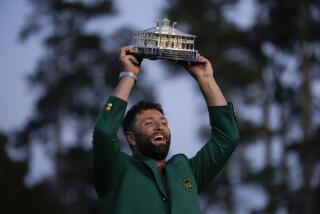Win one for the chipper
AUGUSTA, GA. — The three-way playoff for the 1987 Masters title looked like a major mismatch.
There were Greg Norman, the No. 1-ranked player in the world, and Seve Ballesteros, the best player in Europe. Then there was Larry Mize, 28, a five-year pro, a graduate of qualifying school, a one-time winner and a local guy, the son of a telephone company employee. As a teen, he hung numbers on the scoreboard at the third hole at the Masters.
Up against such heavyweights, the chances of Mize winning were about as good as Rae’s Creek flowing backward.
Mize, after all, had won only once, at the Danny Thomas Memphis Classic, and that was four years before. Just to reach the playoff this time, Mize had to birdie the 18th hole, which he did with a three-wood, a nine-iron and a six-foot putt that found the bottom of the hole.
That putt was a pressure shot, but it would not measure up to what was to come.
It was 20 years ago that Mize added his name to Masters lore, holing out from 140 feet on the second playoff hole for a birdie at the 11th, setting in motion one of the most unexpected turns of events ever produced in the pristine setting of Augusta National Golf Club.
For Norman, it was another crushing defeat. He had watched Bob Tway hole out from a bunker to beat him at the 1986 PGA Championship in his previous major. And his 1996 flameout at the Masters was a long way off.
Ballesteros would never finish as high again at the Masters.
Mize would win only twice more on the PGA Tour, both in 1993, and hasn’t placed in the top 125 on the money list since 2001.
But for that one instant, it was a very different scene, when Mize took his sand wedge and played a little bump-and-run shot and saw the ball get closer and closer, then disappear into the hole.
It’s still hard for Mize to believe.
“The older I get, and looking back, it’s just incredible,” he said.
Maybe it was just meant to be. Ben Crenshaw and Roger Maltbie were tied for the Masters lead after 54 holes at four-under 212, but Norman and Bernhard Langer were only one shot back after Norman’s 66 in the third round. Ballesteros, Mize, Curtis Strange and T.C. Chen began the last round in a tie for fifth at two-under 214.
When Crenshaw and Maltbie faded with matching 74s, the door was left open and Mize, Norman and Ballesteros walked in.
Mize knew he had to birdie the last hole to have any chance, and from 140 yards, he knocked it onto the green. The ball landed by the pin, rolled up the slope and then back down. He rolled in the putt to finish a round of one-under 71 for a 72-hole score of 285 and waited for Ballesteros and Norman to finish.
“People forget he had to birdie the last hole,” Crenshaw said. “That was classic, right there.”
With Ballesteros and Norman joining him in a playoff, the ninth in Masters history, Mize was in the company of golf royalty. Ballesteros had already won the British Open in 1979 and 1984 and the Masters in 1980 and 1983. Among Norman’s five PGA Tour victories was the 1986 British Open, which he won by five shots. And Norman had held the lead going into the last day of all four majors in 1986.
Mize made a quick assessment of his situation.
“I am definitely the underdog in that group,” he said. “But Greg and I went six holes in a playoff [won by Norman] in the 1986 Kemper Open, so obviously that helped me. I knew Seve and Greg both, but these were two tough customers.”
The first playoff hole was the 10th, where Ballesteros three-putted for bogey and was done.
“Now it’s only one tough customer,” Mize said.
For Crenshaw, watching Ballesteros afterward left a lasting impression.
“Poor Seve,” he said, “walking back up the 10th fairway, he was so forlorn.”
At the 11th, Mize hit a good drive and had a five-iron for his second shot. He wanted to draw the ball into the pin, but he blocked it and the ball went right of the green, leaving him a difficult chip shot back. Norman was on the right edge of the green with a long putt for birdie.
“I wasn’t very happy,” Mize said. “I left myself a tough shot. But I thought that if I could hit a good chip shot, it would put pressure back on Greg. I had the ball back in my stance, hit a little bump and run and held the follow-through. It looked good. It got closer to the hole ... and it went in.
“I was frozen. It’s so funny to watch tape of it now. I threw the club into the air and ran around and started screaming like a madman.”
Norman still had a chance, if he made his putt, but Mize said the electricity of the chip-in affected his opponent.
“Obviously that’s not what you’re expecting. He hit the putt, but it’s such a hard putt to halve the hole.”
It didn’t go in, and Norman had another crushing defeat. Soon after, he would sit on the beach at 3 a.m. and weep, but in the moment following his loss, Norman had a quip for the media about Mize’s chip-in for birdie.
“I didn’t think Larry could get down in two from where he was, and I was right.”
As for Mize, he had a moment of glory that he can relive many times over, two decades later.
“That was the golfing thrill of a lifetime, a dream come true,” he said.
Crenshaw is something of a Masters historian and says Mize’s shot was one for the ages.
“It’s probably right there with Gene Sarazen’s double eagle and Tiger’s chip-in on 16. It was one of those historic golf shots,” Crenshaw said. “It’s preposterous that it went in. It was a beautiful shot, but man alive, what it meant.
“Poor old Greg, I’ll tell you. It was just a fantastic shot by Larry. I don’t even know how to describe it. But nobody will ever forget it.”
Mize is at the head of that group. He lived on Aumond Road in Augusta, between Walton Way and Wheeler Road, and started going to the Masters in the 1960s. Once he got Lionel Hebert’s autograph, but Jack Nicklaus was his hero. When Mize was 13 he was old enough to work the scoreboard at the third hole, which he did for two years, until the family moved to Columbus, Ga.
The 1987 Masters winner’s paycheck was $162,000 -- Phil Mickelson earned $1.26 million last year -- but Mize couldn’t believe his good fortune. He wound up sixth on the PGA Tour money list in 1987 with $561,407, the highest position in his career, and other opportunities to improve his finances grew quickly.
Mize signed new club and clothing contracts and had chances to play more outings and to play overseas, which he did at the 1987 Swiss Open.
Mize, who turns 49 in September, last won 14 years ago, at the Northern Telecom Open and the Buick Open.
He made eight cuts in 18 PGA Tour events last year and was 188th on the money list with $217,971.
But those are only numbers, not memories. Mize still lives in Columbus, he’s still playing the tour and he’s still the 1987 Masters champion, thanks to one unbelievable swing with a sand wedge.
“It’s still incredible to think back about it,” he said. “I’m maybe even more thrilled by the thought of it now, not that I wasn’t thrilled before, but your perspective gets a little better as the years go by. And now, there have been 20 of them.”
More to Read
Go beyond the scoreboard
Get the latest on L.A.'s teams in the daily Sports Report newsletter.
You may occasionally receive promotional content from the Los Angeles Times.










